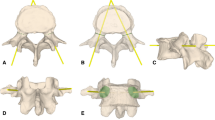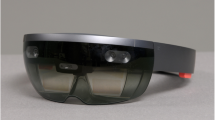Abstract
Objective
This study aims to explore the real-time navigation with guide template using an augmented reality head-mounted device (ARHMD) for pedicle screw placement.
Methods
The spatial coordinate relationships between augmented reality images and real objects were established through the custom-made guide template, and the registration and tracking were completed using an ARHMD. The feasibility and accuracy of this method were verified by pedicle screw placement in 2 lumbar models. According to the Gertzbein–Robbins grading scale, the accuracy of pedicle screw placement was assessed. The navigation errors were estimated by measuring the deviation values of entry point and trajectory angle.
Results
A total of 20 pedicle K-wires were placed into L1–L5 in 2 lumbar models, which were successfully completed, with an average time of 11.5 min per model and 69 s per screw. The overall K-wires placement accuracy was 100% (20 screws). The navigation error was 2.77 ± 0.82 mm for the deviation value of entry point, and 3.03° ± 0.94° for the deviation value of trajectory angle.
Conclusions
The application of an ARHMD combined with guide template for pedicle screw placement is a promising navigation approach.




Similar content being viewed by others
Data availability statement
The data that support the findings of this study are available from the corresponding author [Peihai Zhang], upon reasonable request.
References
Kim, Y. J., Lenke, L. G., Bridwell, K. H., Cho, Y. S., & Riew, K. D. (2004). Free hand pedicle screw placement in the thoracic spine: Is it safe? Spine (Phila Pa 1976), 29, 333–342.
Boriani, S., Bandiera, S., Donthineni, R., Amendola, L., Cappuccio, M., & De Iure, F. (2010). Morbidity of en bloc resections in the spine. European Spine Journal, 19, 231–241.
Bydon, M., Xu, R., Amin, A. G., et al. (2014). Safety and efficacy of pedicle screw placement using intraoperative computed tomography: Consecutive series of 1148 pedicle screws. Journal of Neurosurgery: Spine, 21, 320–328.
Arand, M., Hartwig, E., Kinzl, L., & Gebhard, F. (2002). Spinal navigation in tumor surgery of the thoracic spine: First clinical results. Clinical Orthopaedics and Related Research, 399, 211–218.
Kosmopoulos, V., & Schizas, C. (2007). Pedicle screw placement accuracy: A meta-analysis. Spine (Phila Pa 1976), 32(3), E111–E120.
Tian, N. F., Huang, Q. S., Zhou, P., Zhou, Y., Wu, R. K., Lou, Y., & Xu, H. Z. (2011). Pedicle screw insertion accuracy with different assisted methods: A systematic review and meta-analysis of comparative studies. European Spine Journal, 20, 846–859.
Hartl, R., Lam, K. S., Wang, J., Korge, A., Kandziora, F., & Audige, L. (2013). Worldwide survey on the use of navigation in spine surgery. World Neurosurgery, 79, 162–172.
Hussain, I., Cosar, M., Kirnaz, S., Schmidt, F. A., Wipplinger, C., Wong, T., & Härtl, R. (2020). Evolving navigation, robotics, and augmented reality in minimally invasive spine surgery. Global Spine Journal, 10, 22S-33S.
Yang, B. P., Wahl, M. M., & Idler, C. S. (2012). Percutaneous lumbar pedicle screw placement aided by computer-assisted fluoroscopy-based navigation: Perioperative results of a prospective, comparative, multicenter study. Spine (Phila Pa 1976), 37(24), 2055–2060.
Tajsic, T., Patel, K., Farmer, R., et al. (2018). Spinal navigation for minimally invasive thoracic and lumbosacral spine fixation: Implications for radiation exposure, operative time, and accuracy of pedicle screw placement. European Spine Journal, 27(8), 1918–1924.
Chapman, T. M., Blizzard, D. J., & Brown, C. R. (2016). CT accuracy of percutaneous versus open pedicle screw techniques: A series of 1609 screws. European Spine Journal, 25(6), 1781–1786.
Ohba, T., Ebata, S., Fujita, K., et al. (2016). Percutaneous pedicle screw placements: Accuracy and rates of cranial facet joint violation using conventional fluoroscopy compared with intraoperative three-dimensional computed tomography computer navigation. European Spine Journal, 25(6), 1775–1780.
Silbermann, J., Riese, F., Allam, Y., et al. (2011). Computer tomography assessment of pedicle screw placement in lumbar and sacral spine: Comparison between free-hand and O-arm based navigation techniques. European Spine Journal, 20, 875–881.
Shin, M. H., Ryu, K. S., & Park, C. K. (2012). Accuracy and safety in pedicle screw placement in the thoracic and lumbar spines: Comparison study between conventional C-arm fluoroscopy and navigation coupled with O-arm guided methods. Journal of Korean Neurosurgical Society, 52, 204–209.
Léger, É., Drouin, S., Collins, D. L., et al. (2017). Quantifying attention shifts in augmented reality image-guided neurosurgery. Healthcare Technology Letters, 4(5), 188–192.
Gabbard, J. L., Mehra, D. G., & Swan, J. E. (2019). Effects of AR device context switching and focal distance switching on human performance. IEEE Transactions on Visualization and Computer Graphics, 25(6), 2228–2241.
Herrlich, M., Tavakol, P., Black, D., Wenig, D., Rieder, C., Malaka, R., & Kikinis, R. (2017). Instrument-mounted devices for reducing cognitive load during surgical navigation. International Journal of Computer Assisted Radiology and Surgery, 12(9), 1599–1605.
Ghaednia, H., Fourman, M. S., Lans, A., Detels, K., Dijkstra, H., Lioyd, S., Sweeney, A., Oosterhoff, J. H. F., & Schwab, J. H. (2021). Augmented and virtual reality in spine surgery, current applications and future potentials. The Spine Journal, 21(10), 1617–1625.
Abe, Y., Sato, S., Kato, K., Hyakumachi, T., Yanagibashi, Y., Ito, M., & Abumi, K. (2013). A novel 3D guidance system using augmented reality for percutaneous vertebroplasty: Technical note. Journal of Neurosurgery: Spine, 19(4), 492–501.
Liebmann, F., Roner, S., von Atzigen, M., Scaramuzza, D., Sutter, R., Snedeker, J., Farshad, M., & Furnstahl, P. (2019). Pedicle screw navigation using surface digitization on the Microsoft HoloLens. International Journal of Computer Assisted Radiology and Surgery, 14, 1157–1165.
Molina, C. A., Theodore, N., Ahmed, A. K., Westbroek, E. M., Mirovsky, Y., Harel, R., Orru’, E., Khan, M., Witham, T., & Sciubba, D. M. (2019). Augmented reality-assisted pedicle screw insertion: A cadaveric proof-of-concept study. Journal of Neurosurgery: Spine, 29, 1–8.
Urakov, T. M., & Wang, M. Y. (2019). Levi AD (2019) Workflow caveats in augmented reality-assisted pedicle instrumentation: Cadaver lab. World Neurosurgery, 126, e1449–e1455.
Wei, P., Yao, Q., Xu, Y., Zhang, H., Gu, Y., & Wang, L. (2019). Percutaneous kyphoplasty assisted with/without mixed reality technology in treatment of OVCF with IVC: A prospective study. Journal of Orthopaedic Surgery and Research, 14, 255.
Dennler, C., Jaberg, L., Spirig, J., Agten, C., Gotschi, T., Furnstahl, P., & Farshad, M. (2020). Augmented reality-based navigation increases precision of pedicle screw insertion. Journal of Orthopaedic Surgery and Research, 15, 174.
Molina, C. A., Phillips, F. M., Colman, M. W., Ray, W. Z., Khan, M., Orru, E., Poelstra, K., & Khoo, L. (2020). A cadaveric precision and accuracy analysis of augmented reality-mediated percutaneous pedicle implant insertion. Journal of Neurosurgery: Spine. https://doi.org/10.3171/2020.6.SPINE20370
Buch, V. P., Mensah-Brown, K. G., Germi, J. W., Park, B. J., Madsen, P. J., Borja, A. J., Haldar, D., Basenfelder, P., Yoon, J. W., Schuster, J. M., & Chen, H. I. (2021). Development of an intraoperative pipeline for holographic mixed reality visualization during spinal fusion surgery. Surgical Innovation, 28(4), 427–437.
Yanni, D. S., Ozgur, B. M., Louis, R. G., Shekhtman, Y., Iyer, R. R., Boddapati, V., Iyer, A., Patel, P. D., Jani, R., Cummock, M., Herur-Raman, A., Dang, P., Goldstein, I. M., Brant-Zawadzki, M., Steineke, T., & Lenke, L. G. (2021). Real-time navigation guidance with intraoperative CT imaging for pedicle screw placement using an augmented reality head-mounted device: A proof-of-concept study. Neurosurgical Focus, 51(2), E11.
Gertzbein, S. D., & Robbins, S. E. (1990). Accuracy of pedicular screw placement in vivo. Spine (Phila Pa 1976), 15, 11–14.
Acknowledgements
Thanks to numerous individuals participated in this study.
Funding
No.
Author information
Authors and Affiliations
Corresponding authors
Ethics declarations
Conflict of interest
We declare that no associations with commercial entities that provided support for the work reported in the submitted manuscript. No associations with commercial entities that could be viewed as having an interest in the general area of the submitted manuscript. Non-financial associations that may be relevant to the submitted manuscript.
Ethical standard statement and informed consent
It is a model study without animal or human tissue. No ethical approval and informed consents are required.
Additional information
Publisher's Note
Springer Nature remains neutral with regard to jurisdictional claims in published maps and institutional affiliations.
Rights and permissions
Springer Nature or its licensor (e.g. a society or other partner) holds exclusive rights to this article under a publishing agreement with the author(s) or other rightsholder(s); author self-archiving of the accepted manuscript version of this article is solely governed by the terms of such publishing agreement and applicable law.
About this article
Cite this article
Li, H., Zhang, P., Wang, G. et al. Real-Time Navigation with Guide Template for Pedicle Screw Placement Using an Augmented Reality Head-Mounted Device: A Proof-of-Concept Study. JOIO 57, 776–781 (2023). https://doi.org/10.1007/s43465-023-00859-w
Received:
Accepted:
Published:
Issue Date:
DOI: https://doi.org/10.1007/s43465-023-00859-w




